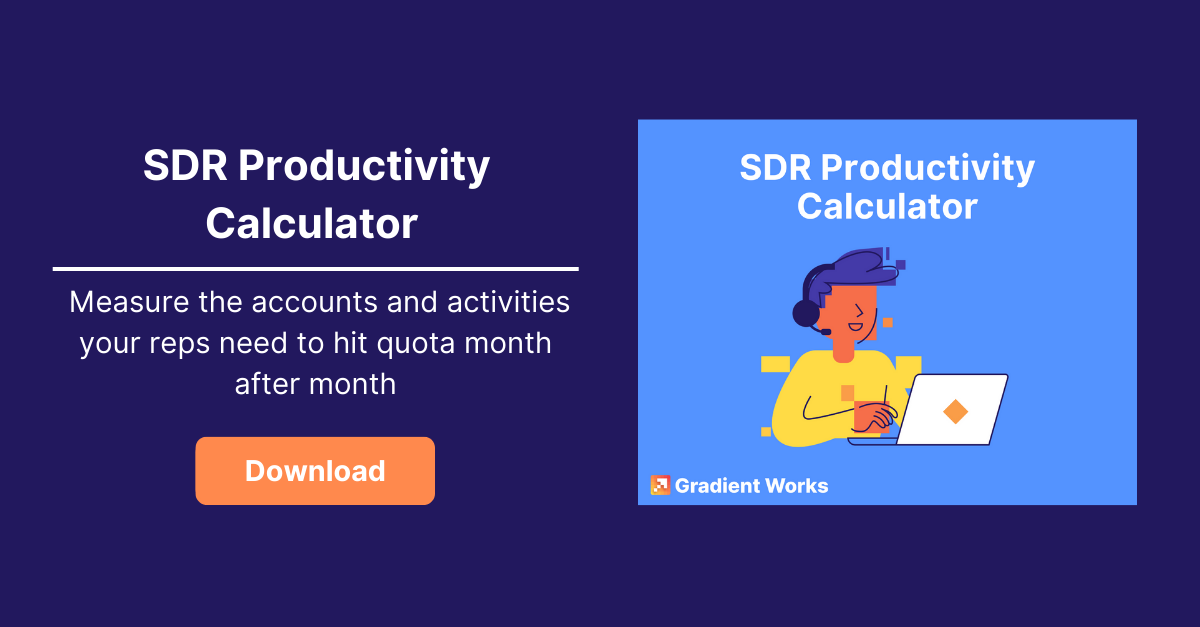A lot of well-meaning SDR leaders set their SDRs up to fail. And it's usually not because of enablement, contact data, or sales engagement tools.
It's also not because reps aren't putting in the work. Most reps work hard to do the right thing.
It often comes down to a misguided idea about measuring the ratio of activity to meeting sets, when what we're really doing is turning accounts into meetings. When we talk about rep productivity, we need to think about both how much they can (and need to) do in a given day or week, as well as the accounts they're working on.
Do you know what your reps' book level of productivity rate should be? If it's too high, you're missing out on deals because your reps are likely spending time on the wrong accounts. A high book productivity percentage means that every month, the reps' accounts need to be both high fit and high timing or they'll struggle.
What is book productivity?
First, let's talk about book productivity and how you measure it. We think of the "book productivity rate" as the percentage of accounts an SDR needs to turn into meetings to hit their quota. For example, if SDR is expected to set 10 meetings a month, and they work 100 accounts each month, they would need a 10% productivity rate to hit quota.
When you pair this book productivity calculation formula rate with an activity-based capacity model, you can get a clearer view of what you're actually asking your reps to do to succeed. If they're doing the right things and still not getting close to their number, then maybe it has to do with the accounts they're working.
The book productivity rate helps you think about whether or not your reps have the quantity and type of accounts they need to succeed at the rate you're asking them to perform.
Calculating your book productivity rate
Let's work through an example together. (And we've created a free spreadsheet you can download to use for your own calculations here).
You'll need 4 numbers to start:
- Touches per day: The total number of activities (emails, calls, etc) a rep is expected to do per day
- Touches per contact: The total number of times you expect an SDR to reach out to a contact
- Contacts per account: The average number of contacts on an account you expect a rep to reach out to
- Monthly quota: The number of meetings/opportunities/demos you expect a rep to book each month
In addition, if your SDRs have a territory or book of accounts, then you can also use territory or book size (the number of accounts in a rep's name at any time (this is optional).
So for our example, let's say you expect an SDR to do 100 activities a day, and touch each contact 10 times before an account is worked to completion. Your ICP is SMBs, so you generally only have 1 contact per account. And to be on quota, a rep has to set 10 meetings per month.
That means a rep can cover 200 accounts a month, and would need to convert 5% of those to be on quota. That's the rep's level of productivity and one that shouldn't be too difficult to achieve if the rep is working the right accounts and putting in the work. In fact, even if the rep isn't working very qualified accounts, they're bound to convert 5% of them by just working harder.

But what happens when we tweak those numbers just a little? Let's hold everything constant except the contacts per account. Even a small business could have 2 contacts you want to reach out to. That suddenly makes it harder for a rep to hit quota. They can now only cover 100 accounts per month, and would need to convert 10% of those. That means you should do everything you can to be sure those 100 accounts are high potential.

And to add another wrinkle, we know that the average B2B SDR quota is more than 10 meetings a month - it's typically more like 15-20. At 1 contact per account, the rep productivity rate is 7.5%, which is starting to become difficult. And with 2 contacts per account, it's 15%, and that's very hard. You definitely want to be sure they're working highly qualified accounts if they need to convert 15% of them.
So as you're thinking about the activity you expect from reps, this productivity calculation formula can help you figure out the ideal SDR rates given your ICP and sales cycle. And do your reps have the accounts they need to be successful in your model?
Want to try it for your SDRs? Get the calculator free here.





